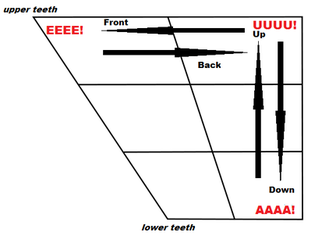Vowel Awareness
We create vowels by completely opening the vocal tract and allowing air to flow out unobstructed. What determines the sound of a vowel is the position of your tongue within your mouth.
In the next section, you will tune your French vowels by listening to audio examples and adjusting your tongue up or down and front or back until the sounds match.
In the next section, you will tune your French vowels by listening to audio examples and adjusting your tongue up or down and front or back until the sounds match.
Vowel Height
|
|
You should have noticed that your tongue and lower jaw have to move all the way down to create the "AAAA!" sound. Since this movement opens up the oral cavity more, we define this vowel sound as OPEN.
On the other end, the tongue has to move almost all the way UP until it almost completely blocks the oral tract to create the "UUUU!" sound. For this reason, we define this vowel sound as CLOSED.
On the other end, the tongue has to move almost all the way UP until it almost completely blocks the oral tract to create the "UUUU!" sound. For this reason, we define this vowel sound as CLOSED.
Vowel Backness
|
|
Here, you should have noticed that your tongue must move forward toward your teeth to make the "EEEE!" sound. We define this vowel sound as a FRONT vowel. To go back to the "UUUU!" sound, you have to retract your tongue back deeper into your mouth. As such, we define this vowel sound as a BACK vowel.
Visualizing Vowel Tuning
|
The chart to the right is a Vowel Chart. A vowel chart visually shows you the location of a vowel within your mouth.
The three vowel sounds reviewed on this page represent the extremes in Vowel Height and Backness. In other words, the remaining vowel sounds for a given language are going to occur at some point between these three extremes. For this to work, you need to develop a sense of direction. |
|
|
When you think you are comfortable, move on to the next page to start "tuning" your French vowels.
Awareness | Tuning | Rounded Vowels | Nasal Vowels | English Tendencies | Consonants | Phonetic Notation Key


